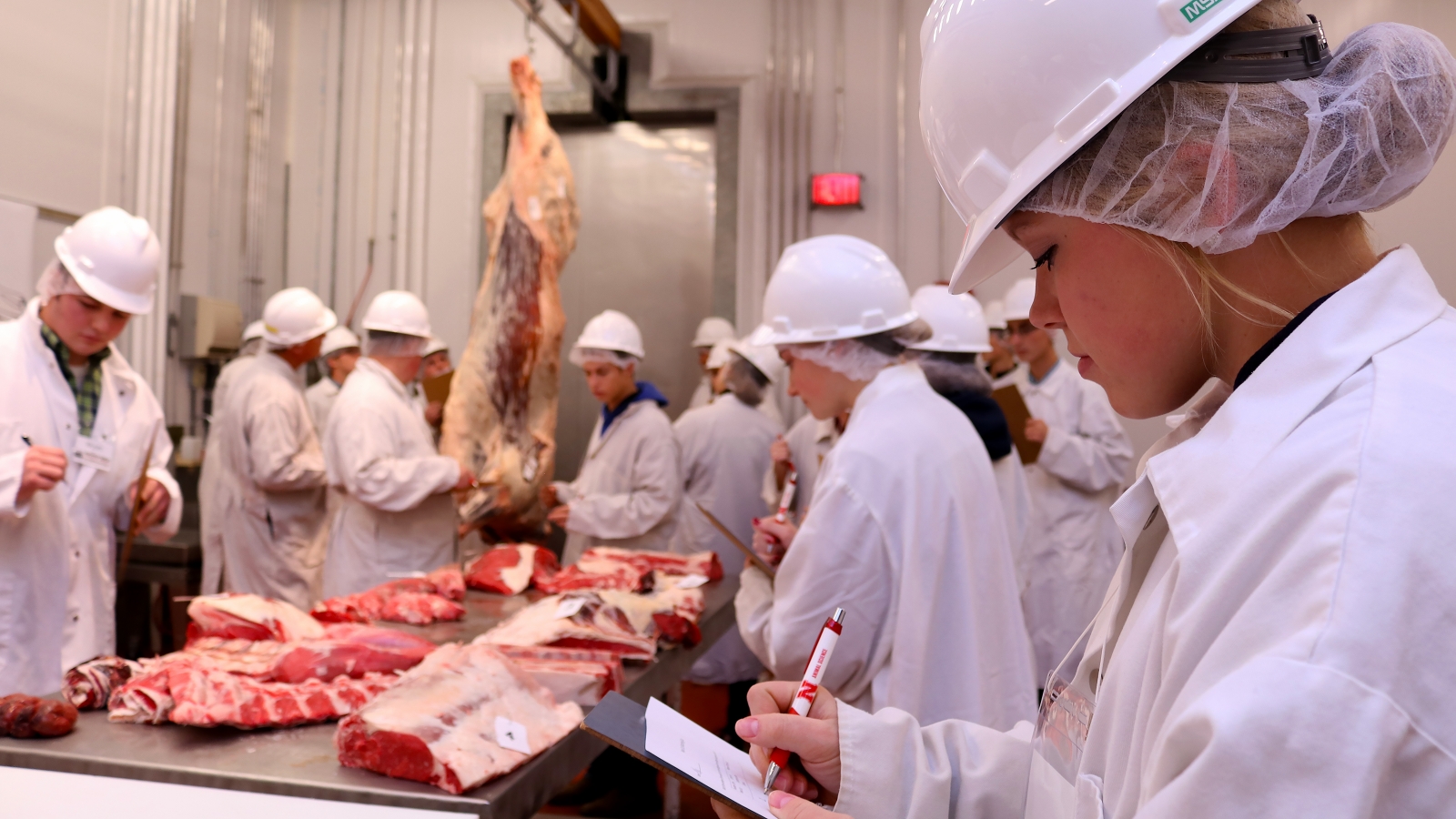The meat science program at the University of Nebraska-Lincoln is renowned for its comprehensive approach to meat science education, research, and outreach. With a focus on improving the quality and sustainability of meat and meat products, meat science offers students robust learning in opportunities with engaging classes, practical hands-on learning experiences and cutting-edge research that will undoubtedly prepare them to be future leaders within the industry. Our students learn from a diverse group of faculty members with expertise ranging from animal growth to animal welfare, and from basic science to the implementation of artificial intelligence and processing technologies. Located in the heart of US meat production, Nebraska promotes innovation today that will ensure high quality and sustainable meat for tomorrow.
Program Features
USDA Inspected Meat Lab /Cattle and Carcass Training Center
The Loeffel Meat Lab boasts a 25,000 square foot meat processing facility that encompasses animal harvesting, fresh meat fabrication and cutting, as well as advanced capabilities for further processing. The meat lab also serves as one of the three USDA Cattle and Carcass Training Centers. We also sell fresh and frozen meat products in our retail sales operation, the Loeffel Meat Shoppe.
Engaging and Collaborative Faculty
Our graduate specialization offers students the opportunity to collaborate with a wide array of animal and food science faculty and their research groups, offering unique opportunities to develop a diverse and well-rounded skill set.
Innovative and Applied Research
With a legacy of innovation spanning over 100 years, the University of Nebraska-Lincoln continues to lead the world in understanding the underlying mechanisms that influence wholesome, safe and sustainable meat production. Our strong industry partnerships further translate our work into applied practices that continue to move the industry forward.
Notable Courses
Food Quality Assurance (FDST 803)
Quality related issues as they pertain to manufacturing, processing, and/or testing of foods, with a major emphasis on food regulations, statistical process control and Hazard Analysis of Critical Control Points (HACCP).
Meat Technology (ASCI 817)
Meat processing and fabrication technology. Practical application of tenderization, restructuring, freezing, dehydration, flavor modification, composition control and quality control technology to manufactured and processed meat products.
Endocrinology (ASCI 842)
Mammalian endocrine glands from the standpoint of their structure, their physiological function in relation to the organism, the chemical nature and mechanisms of action of their secretory products, and the nature of anomalies manifested with their dysfunction.
Advanced Food Science: Selected Topics (FDST 880)
Lorem ipsum odor amet, consectetuer adipiscing elit. Venenatis convallis tincidunt amet potenti sit ex risus eleifend. Molestie primis potenti phasellus diam leo nunc suscipit.
Advanced Meat Science (ASCI 917)
Molecular events occurring during the conversion of muscle to meat. Molecular and cellular properties of meat responsible for the functional and palatability properties of meat products.
Growth and Development of Meat Animals (ASCI 918)
Growth and development of livestock animals with emphasis on the prenatal and postnatal differentiation and development of skeletal muscle, bone, and adipose tissue; organ growth discussed. Recent literature as well as classical concepts of animal growth discussed along with the genetic, hormonal, and nutritional factors that affect growth.
Other Graduate Courses
These are just some of the courses you will take in our graduate program. Click below to learn more about our other animal science graduate courses.
Explore CoursesAnimal Science Graduate Programs
- Typically completed in 2 years
- 30 credit hours required
(including 6-10 research thesis hours)
- Typically completed in 4-5 years after the B.S. degree or 2-3 years beyond the M.S. degree.
- One half (90 credit hours beyond the B.S. degree) must be completed at the University of Nebraska-Lincoln.
- A professional degree in agricultural science, community development and natural resources at the master’s level
- Flexibility that allows you to design an area of study that addresses your educational goals
- Online courses allowing you to earn the degree remotely
- Animal Science
- Beef Cattle Nutrition
- Extension Education Experience
- Teaching Engagement Experience
Huskers Do Big Things
Program Alumni
- Dr. Nicolas Herrera, Tyson Foods
- Dr. Sam Watson, Penn State University (Postdoctoral Fellow)
- Dr. Rebecca Furbeck, Kerry Ingredients and Flavors
- Joseph Sonderman, Greater Omaha Packing Co.
- Avery Vieregger, Mirco Technologies
- Derek Schroeder, UltraSource LLC
Our Research
Our meat science research ranges from animal growth and development, through fresh meats and processed/manufactured meat products.
Explore ResearchOur Faculty
Prior to applying, please contact a specific animal science faculty member in your area of interest. Click below to meet some of our faculty in this specialization.
Meet the Specialization FacultyQuestions? We're Here to Help
If you have questions about any of our specializations within the Animal Science graduate program, please contact a member of our graduate student services team below.


